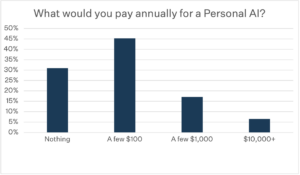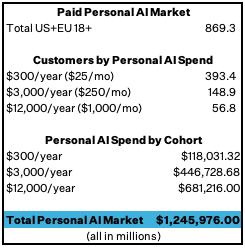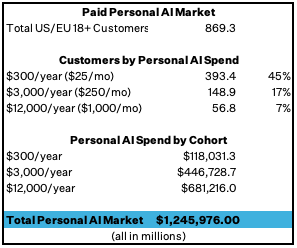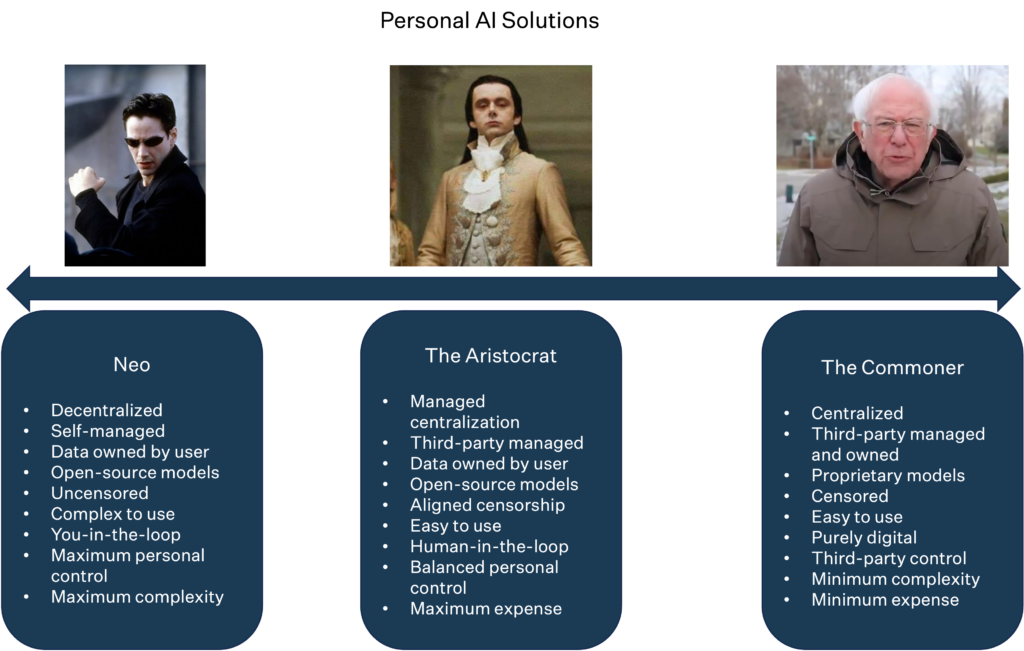Last week, we talked about the trillion-dollar opportunity in Personal AI. As a reminder, a Personal AI is “a chief of staff for your life…a scheduler, an organizer, an advocate, a buyer, a booker,” per Mustafa Suleyman, Inflection AI’s CEO. More than that, a Personal AI is trained on our data and knows us intimately. Whether we control how that data is used to serve us will depend on whether we pay for the service or not.
I ran a recent poll where ~70% of respondents say they’d pay some amount for a Personal AI. In this post, we quantify the potential of the paid Personal AI market given the survey data.
The People Want to Pay for Personal AI
When you use free software, you’re the product. When you pay for software, you’re the customer.
Credit where due, that’s not my original idea. I forget where I heard it first, but the idea sticks. On social networks, you are most obviously the product. The game of social is to keep your attention on the content, which means in a not so subtle way, we work for the network. Most of us would admit that we serve our social networks more than they serve us if we could pry ourselves away from Instagram or TikTok.
Is this the best path for AI?
Do we want our AIs to be attention harvesting tools, trapping us in an endless flow of stimulating dialogue?
Or, do we want our AIs to work for us?
If we could similarly pry ourselves away from ChatGPT, most of us would choose the latter. Our desire to be the customer of AI rather than the product demands a follow up question:
What are you willing to pay for an AI that works for you?
I ran a poll on Twitter and LinkedIn asking just that. With 245 responses, the answer was that almost 70% of people would pay something for a Personal AI.

The results favored a paid model more than expected. I assumed most people wouldn’t be willing to pay anything for a Personal AI since we’re spoiled by so many great free software products.
Maybe I shouldn’t have been that surprised. I pay $240/year for ChatGPT Plus just to get access to GPT 4 and plugins. Maybe it’s just that AI has captured our imagination in the current moment. Or maybe we instinctively understand the power of AI and the desire for a customer vs servant relationship.
If ~70% of people really would pay something for a Personal AI, then a paid approach might be the best way to monetize AI in a massive way.
The Math to $1 Trillion in Paid Personal AI
Assume my Personal AI polling data is correct and apply it to the US and EU markets for customers 18+. You get a $1.25 trillion Personal AI market.

I can already hear the objections. ElevenLabs prompt, in a whiny voice say:
“The survey sample size is small. No one will pay for an AI when they can get it for free. People are never going to spend $12,000 per year for a Personal AI. This is never going to happen.”
Rational skepticism is the best path to discover truth, but these objections are boring.
First, the survey is meant to be directional, not definitive. No survey is. Only events in the market are definitive. Since there’s no paid Personal AI available now, the survey will have to do. Some people will pay. Maybe more than we think.
Second, people already pay for AI en masse at costs similar to Internet or wireless bills. I already mentioned the $240/year ChatGPT Plus. Midjourney offers plans that cost between $90-1,200/year. Tesla FSD is $2,400/year.
Third, the average monthly car payment in the US is $725. That’s more a subscription than a loan because we often get a new car with a new payment when the old one runs its course. If AI is to be as transformative, powerful, and potentially dangerous as we all think, it will be more important to us than a vehicle, and we should be willing to pay more than a vehicle. There will be a class of people who pay more for AI than their cars to do everything they can to harness AI for their interests.
But let’s assume my survey is overly optimistic and ratchet down how many people will pay and how much. If only 50% of the market was willing to pay, and most of that was the lower tier, there’s still an almost $700 billion annual market opportunity for paid Personal AI.

Market sizing is more art than science, but even a skeptic should be able to see a path to a trillion dollar market for Personal AI.
Updating My Personal AI Mental Model
In the trillion-dollar Personal AI piece, I outlined three Personal AI business models:
- The Neo – a fully self-managed Personal AI solution for highly technical users.
- The Aristocrat – a Personal AI managed by a third party that users would pay.
- The Commoner – a centralized Personal AI offered for free where the user is the product.

Given the survey data break down between low end ($300/year), mid end ($3,000/year), and high end ($12,000/year) customers, there seems to be a sort of aspirational Aristocrat and a true Aristocrat. A Mercedes vs a Rolls Royce.
The Mercedes Aristocrats ($300-3,000/year customers) will own their data, stay free of centralized control, and not be the product, but not get the same level of customization and capability as the Rolls Royce Aristocrats ($12,000/year customers).
Based on the survey and estimates above, the market for Mercedes Aristocrats and Rolls Royce Aristocrats might be roughly equal.
Are the Mercedes and Rolls Royce Personal Ads built by the same company?
You could make an argument either way. The company that figures out the best scaled solution to helping manage paid Personal AI might win all customers. That winner could offer the common tiers we see across SAAS models of good, better, best.
The other argument is that which AI service we use may become a status symbol. Rolls Royce Aristocrats might want the world to know they’re using the top service. That’s sort of the point of owning an ultra luxury product.
Either way, the winner or winners of the paid Personal AI space could earn hundreds of billions in revenue, equivalent to Google’s current scale (~$300 billion). That would create another trillion-dollar company, maybe something even bigger.